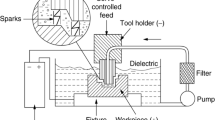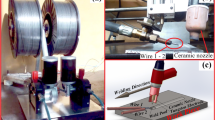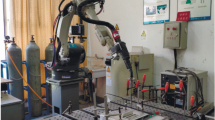Abstract
The quality of a weld joint is highly influenced by depth of penetration. Hence, accurate prediction and maximization of depth of penetration is highly essential to ensure a good-quality joint. This paper highlights the development of neural network model for predicting depth of penetration and optimizing the process parameters for maximizing depth of penetration using simulated annealing algorithm. The process parameters chosen for the study are welding current, welding speed, gas flow rate and welding gun angle. The chosen output parameter was depth of penetration. The experiments were conducted based on design of experiments using fractional factorial with 125 runs. Using the experimental data, feed-forward backpropagation neural network model was developed and trained using Levenberg–Marquardt algorithm. It was found that ANN model based on network 4-15-1 predicted depth of penetration more accurately. A mathematical model was also developed correlating the process parameters with depth of penetration for doing optimization. A source code was developed in MATLAB to do the optimization. The optimized process parameters gave a value of 3.778 mm for depth of penetration.













Similar content being viewed by others
References
Cary HB (1989) Modern welding technology. Prentice Hall, Englewood cliffs
Gridharan PK, Murugan N (2008) Optimization of pulsed welding process parameters for the welding of AISI 304 L stainless steel sheets. Int J Adv Manuf Technol. doi:10.1.1007/S00170-008-1373-0
Tarang YS, Yang WH (1998) Optimization of weld bead geometry in GTAW by Taguchi method. Int J Adv Manuf Technol 14:549–554
Manikya Kanti K, Srinivasa Rao P (2008) Prediction of bead geometry in pulsed GMAW using back propagation neural network. J Mater Process Technol 200:300–305
Li X, Simpson SW, Rados M (2000) Neural networks for online prediction of quality in GMAW. Sci Technol Weld Join 5(2):71–79
Kim IS, Lee SH, Yarlagadda PKDV (2003) Comparison of multiple regression and back propagation neural network approaches in modeling top bead height of multipass GMAW. Sci Technol Weld Join 8(5):347–352
Nagesh DS, Datta GL (2002) Prediction of weld bead geometry and penetration in shielded arc welding using artificial neural networks. J Mater Process Technol 123(2):303–312
Jeng JY, Mau T, Leu S (2000) Prediction of laser butt joint welding parameters using back propagation and learning vector quantization networks. J Mater Process Technol 99:207–218
Mostafa NB, Khajavi MN (2006) Optimization of welding parameters for weld penetration in FCAW. J Achiev Mater Manuf Eng 16:132–138
Esme U, Baramoghu M, Kazancoglu Y, Ozgun S (2009) Optimization of weld bead geometry in TIG welding process using grey relation analysis and Taguchi method. Mater Technol 43:143–149
Thao DS, Kim IS (2009) Interaction model for predicting bead geometry for lab joint in GMA welding process. Comput Mater Sci Surf Eng 1:237–244
Ghazvinloo HR, Honarbakhsh-Raouf A, Shadfar N (2010) Effect of the electrode to work angle, filler diameter and shielding gas on weld geometry of HQ 130 steel joints produced by robotic GMAW. Ind J Sci Technol 3:26–30
Edwin Raja Dhas J, Kumanan S (2007) ANFIS for prediction of weld bead width in a submerged arc welding process. J Sci Ind Res 66:335–338
Correia DS, Concalves CV, Sebastiao Junior SC, Ferraresi VA (2005) Comparison between genetic algorithms and response surface methodology in GMAW optimization. J Mater Process Technol 160:70–76
Sathiya P, Aravindan S, Noorul Haq A, Pannerselvam K (2006) Optimization of friction welding parameters using simulated annealing. Ind J Eng Mater Sci 13:37–44
Kolahan F, Heidari M (2010) Modeling and optimization of MAG welding for gas pipelines using regression analysis and simulated annealing algorithm. J Sci Ind Res 69:259–265
Cochran WG, Cox GM (1963) Experimental designs. Asia Publishing House, India
Vel Murugan V, Gunaraj V (2005) Effect of process parameters on angular distortion of gas metal arc welded structural steel plates. Weld J 84:165-s–171-s
DOE—PC IV (1998) Software reference manual. Quality America, Inc.
Hagan MT, Demuth HB, Beale M (1996) Neural network design. Thomson Learning, Vikas Publishing House, India
Hammerstrom D (1993) Working with neural networks. IEEE Spectr 30:46–53
Kannan T, Murugan N (2006) Artificial neural network modeling of weld bead geometry and dilution in flux cored arc welding. Int J Join Mater 18(2):46–51
MATLAB 7.6 R2008a (2008) The Math Works, Inc.
Yang IJ, Bibby MJ, Chandel RS (1993) Linear regression equations for modeling the submerged arc welding process. J Mater Process Technol 39:33–42
Author information
Authors and Affiliations
Corresponding author
Rights and permissions
About this article
Cite this article
Sudhakaran, R., Vel Murugan, V., Sivasakthivel, P.S. et al. Prediction and optimization of depth of penetration for stainless steel gas tungsten arc welded plates using artificial neural networks and simulated annealing algorithm. Neural Comput & Applic 22, 637–649 (2013). https://doi.org/10.1007/s00521-011-0720-5
Received:
Accepted:
Published:
Issue Date:
DOI: https://doi.org/10.1007/s00521-011-0720-5




